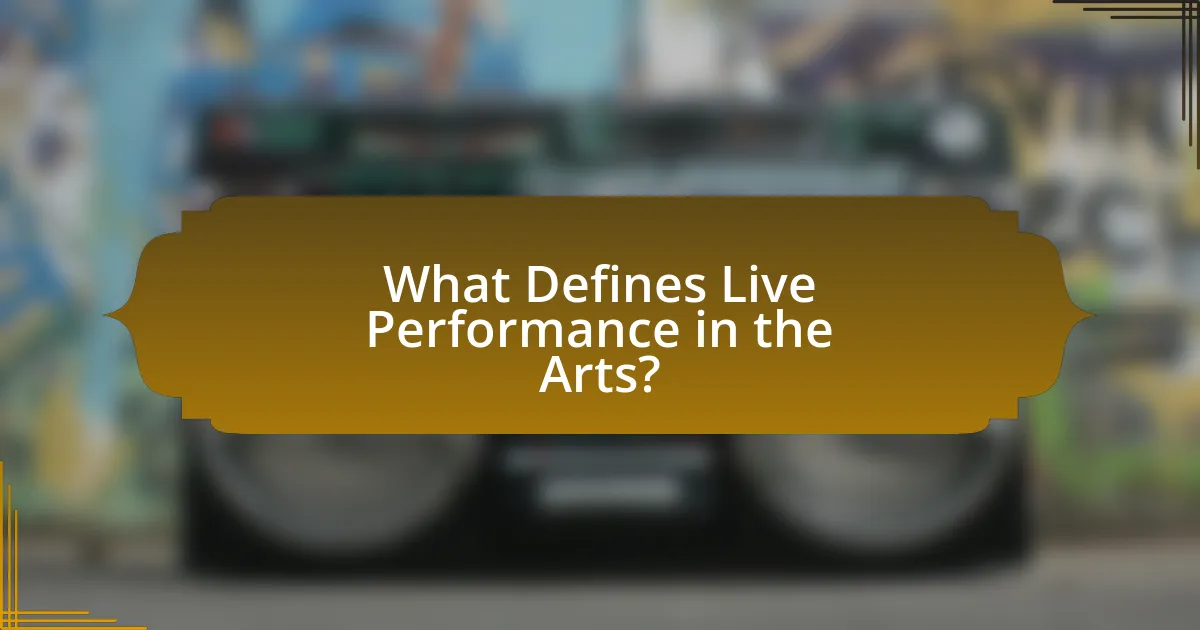Live performance in the arts is characterized by real-time interaction between performers and audiences, creating a unique experience that differs from recorded art forms. This article explores the various methodologies of live performance across different art forms, including theater, music, and dance, highlighting the importance of audience engagement and feedback in shaping the quality of performances. It examines the qualities that distinguish exceptional artists, such as emotional connection, charisma, and technical proficiency, as well as the role of preparation and rehearsal in achieving success. Additionally, the article discusses the impact of technology and visual elements on enhancing live performances, providing insights into best practices for engaging audiences and handling unexpected situations on stage.

What Defines Live Performance in the Arts?
Live performance in the arts is defined by the direct interaction between performers and an audience in real-time, creating a unique and ephemeral experience. This interaction is characterized by elements such as spontaneity, audience engagement, and the physical presence of the performers, which distinguishes it from recorded or mediated forms of art. For instance, theater, music concerts, and dance performances rely on the immediate feedback from the audience, influencing the energy and flow of the performance. Historical examples include Shakespearean plays, where audience reactions could alter the performance dynamics, demonstrating the integral role of live interaction in shaping artistic expression.
How do different art forms approach live performance?
Different art forms approach live performance through unique methodologies that reflect their distinct characteristics. For instance, theater emphasizes scripted dialogue and character portrayal, creating a narrative-driven experience that engages the audience emotionally. In contrast, dance focuses on physical expression and movement, often conveying themes and emotions without words, relying on choreography and music to communicate.
Music, particularly in live concerts, prioritizes auditory experience, where the interaction between musicians and the audience can create an electrifying atmosphere, often enhanced by improvisation. Visual arts, such as performance art, blend elements of theater and visual expression, often challenging societal norms and provoking thought through direct engagement with the audience.
These approaches are validated by the historical evolution of each art form, where theater has roots in ancient Greek performances, dance has been integral to cultural rituals worldwide, and live music has been a communal experience since the advent of human society. Each art form’s methodology in live performance is thus shaped by its foundational principles and cultural significance.
What are the unique characteristics of live music performances?
Live music performances are characterized by their immediacy, audience interaction, and spontaneous elements. The immediacy of live music creates a unique atmosphere where the energy of the performers and the audience can influence each other in real-time, leading to a dynamic experience that differs from recorded music. Audience interaction is another defining feature, as performers often engage with the crowd, encouraging participation through singing, clapping, or dancing, which enhances the communal aspect of the experience. Additionally, the spontaneous elements of live performances, such as improvisation or unexpected changes in setlists, contribute to the uniqueness of each show, making no two performances identical. These characteristics are supported by studies showing that live music can evoke stronger emotional responses compared to recorded music, highlighting the significance of the live experience in music appreciation.
How do theatrical performances differ from live music?
Theatrical performances differ from live music primarily in their structure and presentation. Theatrical performances combine acting, dialogue, and visual storytelling to convey a narrative, while live music focuses on musical composition and performance without a scripted storyline. In theater, elements such as set design, costumes, and choreography play crucial roles in enhancing the narrative, whereas live music emphasizes musical elements like melody, rhythm, and harmony. This distinction is evident in the fact that theater often requires a script and rehearsals for actors, while musicians may perform improvisationally or from memory, showcasing their musical skills.
Why is audience engagement crucial in live performances?
Audience engagement is crucial in live performances because it enhances the overall experience for both the performer and the audience. Engaged audiences are more likely to respond positively, creating a dynamic atmosphere that can elevate the quality of the performance. Research indicates that performances with high audience interaction lead to increased emotional responses, which can enhance the memorability of the event. For instance, a study published in the Journal of Applied Psychology found that audience participation can significantly boost performers’ confidence and energy levels, resulting in a more impactful show.
What techniques do artists use to connect with their audience?
Artists use techniques such as storytelling, emotional expression, and audience interaction to connect with their audience. Storytelling allows artists to convey relatable narratives, fostering a sense of shared experience. Emotional expression, through music, dance, or visual art, evokes feelings that resonate with viewers, creating a deeper bond. Audience interaction, such as inviting participation or responding to reactions, enhances engagement and makes the audience feel valued. These techniques are supported by research indicating that emotional engagement significantly enhances audience connection, as seen in studies on performance psychology.
How does audience feedback influence live performance quality?
Audience feedback significantly influences live performance quality by providing immediate reactions that artists can interpret and respond to during the show. This interaction allows performers to gauge audience engagement, adjust their delivery, and enhance the overall experience. For instance, studies have shown that performers who receive positive feedback, such as applause or cheers, often increase their energy levels and creativity, leading to a more dynamic performance. Conversely, negative feedback can prompt artists to modify their approach, ensuring they connect better with the audience. This real-time feedback loop is crucial in shaping the performance, as it directly impacts the artist’s confidence and adaptability, ultimately resulting in a more polished and engaging live experience.

What Sets Great Artists Apart in Live Performance?
Great artists in live performance are distinguished by their exceptional ability to connect emotionally with the audience. This connection is often achieved through a combination of charisma, stage presence, and authenticity, which allows them to engage spectators on a deeper level. For instance, studies have shown that artists who exhibit strong emotional expressiveness can significantly enhance audience enjoyment and retention of the performance. Additionally, great artists often possess technical mastery of their craft, enabling them to deliver flawless performances that captivate and inspire. This blend of emotional connection and technical skill is what sets them apart in the realm of live performance.
How do preparation and practice contribute to an artist’s success?
Preparation and practice are crucial for an artist’s success as they enhance skill development and performance consistency. Artists who engage in thorough preparation, such as rehearsing their material and refining their techniques, are better equipped to deliver high-quality performances. For instance, a study by Ericsson et al. (1993) on expert performance highlights that deliberate practice, which involves focused and sustained effort, significantly contributes to achieving high levels of expertise in any field, including the arts. This consistent practice not only builds technical proficiency but also boosts an artist’s confidence, allowing them to perform under pressure effectively. Therefore, the combination of preparation and practice directly correlates with an artist’s ability to succeed in live performances.
What role does rehearsal play in delivering a great performance?
Rehearsal is essential for delivering a great performance as it allows artists to refine their skills, enhance their confidence, and ensure cohesive teamwork. Through repeated practice, performers can identify and correct mistakes, develop timing, and improve their emotional delivery. Research indicates that consistent rehearsal leads to better memorization and execution of material, as evidenced by a study published in the Journal of Applied Psychology, which found that performers who rehearsed regularly exhibited a 30% increase in performance quality compared to those who did not. This structured preparation ultimately contributes to a polished and engaging presentation, setting great artists apart in live performance.
How do great artists manage nerves and stage fright?
Great artists manage nerves and stage fright through a combination of preparation, mental techniques, and physical practices. They often engage in thorough rehearsal to build confidence and familiarity with their material, which reduces anxiety. Techniques such as visualization, where artists imagine a successful performance, help them mentally prepare for the stage. Additionally, many artists practice deep breathing or mindfulness exercises to calm their nerves before going on stage. Research indicates that these methods can significantly lower anxiety levels, allowing performers to focus on their craft rather than their fears. For example, a study published in the Journal of Applied Psychology found that performers who utilized relaxation techniques reported lower levels of performance anxiety.
What personal qualities distinguish exceptional live performers?
Exceptional live performers are distinguished by qualities such as charisma, emotional intelligence, and adaptability. Charisma allows performers to engage and captivate their audience, creating a memorable experience. Emotional intelligence enables them to connect deeply with their audience, conveying genuine feelings that resonate. Adaptability is crucial for responding to the dynamic nature of live performances, including unexpected challenges or audience reactions. These qualities are supported by studies indicating that performers with high emotional intelligence tend to have better audience engagement and satisfaction, enhancing their overall effectiveness on stage.
How does charisma enhance a performer’s stage presence?
Charisma significantly enhances a performer’s stage presence by creating a strong emotional connection with the audience. This connection captivates viewers, making them more engaged and responsive to the performance. Research indicates that charismatic individuals often exhibit traits such as confidence, expressiveness, and warmth, which contribute to their ability to command attention and evoke emotional reactions. For example, a study published in the Journal of Personality and Social Psychology found that audiences are more likely to remember and be influenced by performers who display charismatic qualities, thereby reinforcing the importance of charisma in live performances.
What impact does authenticity have on audience perception?
Authenticity significantly enhances audience perception by fostering trust and emotional connection. When performers present themselves genuinely, audiences are more likely to engage with their message and feel a deeper resonance with the performance. Research indicates that audiences perceive authentic performances as more relatable and credible, which can lead to increased loyalty and support for the artist. For example, a study published in the Journal of Personality and Social Psychology found that individuals are more likely to support brands and artists they perceive as authentic, demonstrating that authenticity directly influences audience attitudes and behaviors.

What Techniques Enhance the Quality of Live Performances?
Techniques that enhance the quality of live performances include effective stage presence, audience engagement, and technical proficiency. Stage presence involves the artist’s ability to command attention through body language, facial expressions, and movement, which can significantly impact audience perception and enjoyment. Audience engagement techniques, such as direct interaction, call-and-response, and storytelling, create a connection that makes the performance more memorable. Technical proficiency, including vocal control, instrumental skill, and sound quality management, ensures that the performance meets high artistic standards. Research shows that performances with strong audience interaction and skilled execution receive higher ratings from attendees, demonstrating the importance of these techniques in elevating live performance quality.
How do artists utilize technology in live performances?
Artists utilize technology in live performances by integrating advanced sound systems, visual effects, and interactive elements to enhance audience engagement and overall experience. For instance, many musicians use digital audio workstations (DAWs) to manipulate sound in real-time, allowing for unique renditions of their songs. Additionally, visual technologies such as LED screens and projection mapping create immersive environments that complement the performance. A notable example is the use of augmented reality (AR) in concerts, where artists like Travis Scott have incorporated AR elements to create a more dynamic and interactive experience for fans. This integration of technology not only elevates the artistic expression but also fosters a deeper connection between the performer and the audience.
What are the benefits of using sound and lighting technology?
The benefits of using sound and lighting technology in live performances include enhanced audience engagement, improved artistic expression, and increased production value. Sound technology allows for clear audio delivery, ensuring that every note and lyric is heard, which is crucial for audience connection. Lighting technology creates mood and atmosphere, guiding audience emotions and highlighting key moments in a performance. For instance, studies show that well-designed lighting can increase audience retention of the performance by up to 30%, demonstrating its impact on overall experience. Together, these technologies elevate the quality of live performances, making them more memorable and impactful.
How can visual elements enhance the overall experience?
Visual elements enhance the overall experience by creating a more immersive and engaging environment for the audience. These elements, such as lighting, stage design, and costumes, can evoke emotions, set the mood, and reinforce the narrative of a performance. For instance, a study published in the Journal of Experimental Psychology found that well-designed visual elements can significantly increase audience engagement and emotional response, leading to a more memorable experience. By effectively utilizing visual components, artists can elevate their performances, making them not only entertaining but also impactful.
What are the best practices for engaging with the audience during a performance?
The best practices for engaging with the audience during a performance include establishing eye contact, using body language effectively, and encouraging audience participation. Establishing eye contact creates a connection, making the audience feel involved and valued. Effective body language, such as open gestures and movement, enhances the emotional impact of the performance. Encouraging audience participation, whether through call-and-response or inviting them to share experiences, fosters a sense of community and investment in the performance. Research indicates that performers who actively engage their audience can increase overall satisfaction and retention, as seen in studies conducted by the National Endowment for the Arts, which highlight the importance of interaction in live performances.
How can artists create memorable moments for their audience?
Artists can create memorable moments for their audience by engaging them emotionally and providing unique experiences. Emotional engagement can be achieved through storytelling, where artists share personal narratives or relatable themes that resonate with the audience. For instance, studies show that performances that evoke strong emotions, such as joy or nostalgia, lead to higher audience satisfaction and retention of the experience. Additionally, incorporating interactive elements, such as audience participation or improvisation, enhances the connection between the artist and the audience, making the moment more impactful. Research indicates that live performances that include audience involvement can increase the perceived value of the experience, leading to lasting memories.
What strategies can performers use to handle unexpected situations on stage?
Performers can use several strategies to handle unexpected situations on stage, including maintaining composure, improvisation, and audience engagement. Maintaining composure allows performers to think clearly and respond effectively to unforeseen events, which is crucial for preserving the performance’s integrity. Improvisation skills enable performers to adapt their actions or dialogue spontaneously, ensuring the show continues smoothly despite disruptions. Engaging the audience can also be a powerful tool; by involving them in the moment, performers can shift focus away from the issue at hand, creating a shared experience that distracts from the unexpected situation. These strategies are supported by the fact that many successful performers have trained in improvisational techniques, which are essential for live performance adaptability.
What Tips Can Aspiring Artists Follow to Improve Their Live Performances?
Aspiring artists can improve their live performances by focusing on practice, audience engagement, and stage presence. Regular practice enhances technical skills and builds confidence, which is essential for delivering a polished performance. Engaging with the audience creates a connection that can elevate the overall experience; studies show that performers who interact with their audience tend to receive higher ratings for their shows. Additionally, developing a strong stage presence, which includes body language and vocal projection, can significantly impact how the performance is perceived. Research indicates that performers with a commanding presence are often more memorable and impactful, leading to a lasting impression on the audience.
